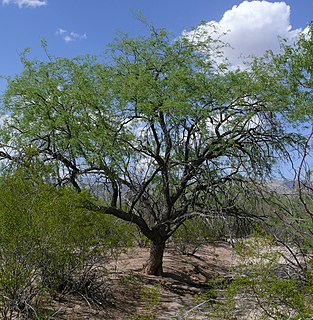
Quercus velutina, the black oak, is a species of oak in the red oak group, native and widespread in eastern and central North America. It is found in all the coastal states from Maine to Texas, inland as far as Michigan, Ontario, Minnesota, Nebraska, Kansas, Oklahoma, and eastern Texas. It is sometimes called the eastern black oak.

Apollonias is a genus of flowering plants belonging to the laurel family, Lauraceae. The genus includes from one to 10 species of evergreen trees and shrubs, depending on circumscription; recent studies have limited the genus to just one species, with the others transferred to Beilschmiedia.

Prosopis velutina, commonly known as velvet mesquite, is a small to medium-sized perennial tree. It is a legume adapted to a dry, desert climate. Though considered to be a noxious weed in states outside its natural range, it plays a vital role in the ecology of the Sonoran Desert.

Fraxinus velutina, the velvet ash, Arizona ash or Modesto ash, is a species of Fraxinus native to southwestern North America, in the United States from southern California east to Texas, and in Mexico from northern Baja California east to Coahuila and Nuevo León.
Heliciopsis is a genus of about thirteen species of trees, constituting part of the flowering plant family Proteaceae. They grow naturally in Burma, Indo-China, SE. China, Thailand, Peninsular Malaysia, Borneo, Sumatra, Java (Indonesia) and the Philippines. The name means similar to the plant genus Helicia. Its closest relatives are Athertonia (Australia) and Virotia.

Maesa is a genus of flowering plants. It is now generally placed in the family Primulaceae, but has been placed previously in Myrsinaceae, or in a family of its own, Maesaceae. There are about 100 species, the majority of which occur in Malesia, New Guinea, western Asia and the Pacific Islands.
Unonopsis magnifolia is a species of plant in the Annonaceae family. It is endemic to Ecuador. Its natural habitat is subtropical or tropical moist lowland forests. It is threatened by habitat loss.

Unonopsis is a genus of plant in family Annonaceae. It contains the following species :

Musa velutina, the hairy banana, or pink banana, is a diploid species of wild banana. These plants are originally from Assam and the eastern Himalayas.

The Asian hornet, also known as the yellow-legged hornet or Asian predatory wasp, is a species of hornet indigenous to Southeast Asia. It is of concern as an invasive species in some other countries.

Erythrina velutina is a species of leguminous tree. It is indigenous to Brazil, Peru, Ecuador, Colombia, Venezuela, and Hispaniola and has been introduced to much of the Caribbean, Uganda, and Sri Lanka. It also occurs on the Galápagos Islands, but whether it is indigenous or introduced there is unclear. In Brazil, it occurs on plains and near rivers in the arid parts of the northeast of the country and is commonly known as "mulungu". Erythrina velutina grows as a large tree to around 10 m (30 ft) high and has short spines on the stem. It is perennial.

Chukrasia tabularis, the Indian mahogany, is a deciduous, tropical forest tree species in the family Meliaceae. It is native to Bangladesh, Cambodia, China, India, Indonesia, Laos, Malaysia, Myanmar, Sri Lanka, Thailand, and Vietnam. Also introduced to many western countries such as Cameroon, Costa Rica, Nigeria, Puerto Rico, South Africa, and United States.

Velutina plicatilis is a species of small sea snail, a marine gastropod mollusk in the family Velutinidae.
Velutina schneideri is a species of small sea snail, a marine gastropod mollusk in the family Velutinidae.

Velutina velutina, common name the velvet shell, is a species of small sea snail with a transparent shell, a marine gastropod mollusk in the family Velutinidae.

Velutina is a genus of small sea snails, marine gastropod mollusks in the family Velutinidae.
Heliciopsis velutina is a species of trees, in the family Proteaceae. They grow up to 25 metres (80 ft) tall, with a trunk diameter of up to 25 cm (10 in). The bark is dark brown. They have reddish brown flowers. They have brown, ellipsoid fruits up to 4 cm (2 in) long. The specific epithet velutina comes from the Latin meaning "velvety", referring to the petiole. They grow naturally in lowland mixed dipterocarp forests' habitats from sea level to 600 metres (2,000 ft) altitude in Peninsular Malaysia and Borneo.

Solidago velutina, the threenerve goldenrod or velvety goldenrod, is a plant species native to Mexico and to the western United States. The species has been found in southwestern Oregon, east to the Black Hills of South Dakota, and as far south as México State in the central part of the Republic of México. It is classified as a member of Subsection Nemorales.
Leucozona velutina is a species of syrphid fly in the family Syrphidae.

Paranomada velutina is a species of cuckoo bee in the family Apidae. It is found in Central America and North America.














